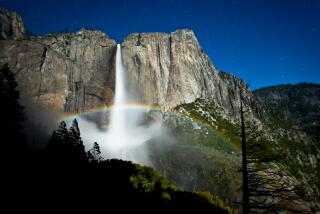THE OUT-OF-VALLEY EXPERIENCE II : Yosemite Falls
I saw the Lower Yosemite Fall thrashed and pulverized from top to bottom into one glorious mass of rainbow dust; while a thousand feet above it the main Upper Fall was suspended on the face of the cliff in the form of an inverted bow, all silvery white and fringed with short wavering strips. Then, suddenly assailed by a tremendous blast ( of wind ) , the whole mass of the fall was blown into threads and ribbons, and driven back over the brow of the cliff whence it came, as if denied admission to the Valley. --MUIR
“The Yosemite”
THE UPPER YOSEMITE FALLS trail is not an easy hike. A 2,700-foot elevation gain in 3.6 miles, it is a staircase into wilderness and near-solitude, illustrating the first lesson in beating the crowds at Yosemite: The number of people diminishes in geometric proportion to the distance above the valley floor--at least in spring and fall.
The falls will be in full, thundering flood in spring as the sun is melting the winter’s deep blanket of snow. The shaded areas along the lower trail may be framed by the delicate spreading arms of dogwood trees, each holding out a perfect blossom of white velvet against the granular, lichened gray of the Yosemite granite. The falls are at their finest then.
Indeed, a whole chorus of waterfalls burst forth everywhere along the rim of the valley during the runoff season. One of the finest is found shyly hiding within Ribbon Fall amphitheater west of El Capitan and on the same side of the valley. Ribbon Fall is a delicate, slender streamer that plunges almost straight down from the rim.
Another splendid cascade streams from the grand east buttress of El Capitan itself. The El Cap fall is best seen in early evening as the westering sun sparkles through the mist, its bannered spray often floating capriciously to and fro on the valley breezes.
The great Yosemite cascade has receded by autumn with the completion of runoff, but the trail offers a special beauty then. Hiking around a corner in the fall, as I once did, I stopped, transfixed. There, bathed in the soft sunlight, stood a mature black oak dressed in the grandest, brightest golden cloak of leaves imaginable. The leaves shimmered against the shadowy face of Half Dome in the background, like something alive.
At the top of the trail, an iron fence keeps enchanted viewers from venturing too close to the cliff’s edge and from emulating Muir, who in his first summer in the Sierra crept out as far as he could on the outermost ledge to experience to the fullest the thunder of the falls as they plunged all the way to the bottom. “Here I obtained a perfectly free view down into the heart of the snowy, chanting throng of comet-like streamers, into which the body of the fall soon separates,” he wrote.
I, too, became entranced by the falls, fixing on one segment of water and trying to follow its slide down the rock, racing to its final plunge into the valley. The effect was hypnotic as I tried to focus on each separate flow all the way to the bottom. No single streamer seems to be precisely like any other. Especially in autumn, the gauzy veil of water may wave this way or that in the wind, playing tricks on gravity. In the end, the individual streams always dash themselves into a common chaos on the rocks before collecting themselves anew for the last dash down the lower cascade to the valley floor.
More to Read
Sign up for The Wild
We’ll help you find the best places to hike, bike and run, as well as the perfect silent spots for meditation and yoga.
You may occasionally receive promotional content from the Los Angeles Times.






